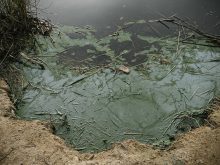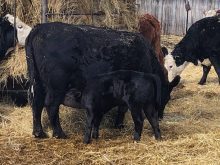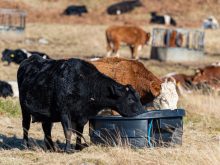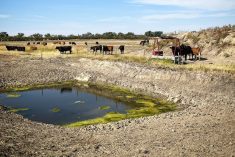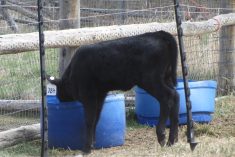Glacier FarmMedia — Researchers are seeking ways to manage antimicrobial-resistant bacteria on farms, including quicker evaluation of bacteria so treatment can be better targeted.
Agriculture and Agri-Food Canada and University of Saskatchewan veterinary school researchers are studying feedlot water troughs, hoping the water can tell them what sort of anti-microbial resistant bacteria are present.
Antimicrobial resistance is a growing problem on Canadian farms and that means infections will be more difficult to treat.
Read Also

Harvest wraps up and fall work begins
At the Eppich famly ranch in western Saskatchewan, the fall harvest was successful with few breakdowns, cows and calves have been sorted and a new tractor has arrived
“By knowing what type of resistance is there, we would avoid the use of antibiotics that those resistance genes confer resistance to,” said Dr. Trevor Alexander, research scientist with AAFC.
Burgeoning anti-microbial resistance on Canadian farms makes infections more difficult to treat.
In 2010, a research project run by Tim McAllister at AAFC showed that about 10 percent of the mannheimia haemolytica bacteria studied on farms were resistant. That bacteria is the most common cause of bovine respiratory disease (BRD) in beef cattle.
About six years later, a follow up study conducted with Edouard Timsit at the University of Calgary found about 70 per cent of bacteria of concern were resistant to antimicrobials.
Antimicrobial resistance grows when antibiotics are repeatedly used on the same farm and the susceptible bacteria are killed, leaving larger numbers of bacteria resistant to that drug.
Research projects around the world are studying how farm management can help reduce such resistance.
Quick testing to determine levels of resistance and identify bacteria that are causing an infection could lead to better treatment decisions.
Alexander, who is based in Lethbridge, worked with Dr. Murray Jelinski, at the Western College of Veterinary Medicine at the University of Saskatchewan, to evaluate bacteria in water bowls in feedlots as a way to monitor for and manage antimicrobial resistance.
They took water from feedlot water bowls and tried to grow mannheimia, histophilus and pasteurella.
Water bowls were chosen because they are visited by all animals in a pen and cattle will stick their noses into the water while drinking, passing bacteria into the water. A nasal swab is now the only effective way to track respiratory disease bacteria in cattle. That involves a lot of individual work with animals.
A water-based test would be a more efficient way to understand the resistant bacteria types that are circulating among cattle in the pen.
“We saw that the survivability was really quite low for histophilus. More than 90 per cent of the bacteria died within 24 hours,” said Alexander.
There were few remaining after three days. That means the test had to be done quicker.
Researchers worked with another feedlot, this time testing for bacteria the same day. That resulted in some isolation of pasteurella, but not histophilus or mannheimia.
“So, those bugs are tricky,” said Alexander. “The methods today, we don’t have a really great method to isolate those bacteria. We don’t have highly selective media to isolate those bacteria.”
They looked at how some bacteria were related and concluded that some were cloned in the pen, meaning they were being passed, likely through water. Researchers are now using metagenomics, the genome analysis of material in a sample from the environment, in this case a water bowl in a pen of cattle, to be sure the bacteria were passed between cattle through the water.
This won’t help identify specific resistance within the genomes of bovine respiratory disease-resistant bacteria, but “we can look at all the resistance genes there and get a good idea of what we already know about resistance in feedlot pens,” said Alexander.
“Once animals come into the pens and the pen density is high, and then they’re sharing water at the water troughs, we do see an increase in the prevalence of BRD pathogens.”
He said there are many good reasons to keep troughs clean, but there are no studies on how often they should be cleaned and how much treatment would be required to reduce pathogen spread.
Other projects in Canada are looking at mobile elements in resistant bacteria that result in spread, and the use of long-read sequencing, a newer type of genetic analysis that could result in quicker, more accurate results of the type of BRD bacteria in a sample from a nasal swab.



